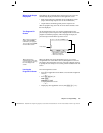
Chapter 17: Programming 283
17PROGRM.DOC TI-89/TI-92 Plus: Programming (English) Susan Gullord Revised: 02/23/01 1:14 PM Printed: 02/23/01 2:18 PM Page 283 of 40
When you run a program, the program lines are executed in
sequential order. However, some commands alter the program flow.
For example:
¦
Control structures such as
If...EndIf
commands use a conditional
test to decide which part of a program to execute.
¦
Loops commands such as
For...EndFor
repeat a group of
commands.
For more complex programs that
use
If...EndIf
and loop structures
such as
For...EndFor
, you can make
the programs easier to read and
understand by using indentation.
:If x>5 Then
: Disp "x is > 5"
:Else
: Disp "x is < or = 5"
:EndIf
In a program, calculated results are not displayed unless you use an
output command. This is an important difference between
performing a calculation on the Home screen and in a program.
These calculations will not display
a result in a program (although they
will on the Home screen).
:12
ù
6
:cos(
p
/4)
:solve(x^2
ì
x
ì
2=0,x)
Output commands such as
Disp
will
display a result in a program.
:Disp 12
ù
6
:Disp cos(
p
/4)
:Disp solve(x^2
ì
x
ì
2=0,x)
Displaying a calculation result does
not store that result. If you need to
refer to a result later, store it to a
v
ariable.
:cos(
p
/4)
!
maximum
:Disp maximum
To input values into a program, you can:
¦ Require the users to store a value (with
§
) to the necessary
variables before running the program. The program can then refer
to these variables.
¦ Enter the values directly into
the program itself.
:Disp 12
ù
6
:cos(
p
/4)
!
maximum
¦ Include input commands that
prompt the users to enter the
necessary values when they
run the program.
:Input "Enter a value",i
:Request "Enter an integer",n
¦ Require the users to pass one
or more values to the
program when they run it.
prog1(3,5)
Controlling the Flow
of a Program
Tip: For information, refer to
pages 295 and 297.
Using Indentation
Displaying
Calculated Results
Tip: For a list of available
output commands, refer to
page 302.
Getting Values into
a Program
Tip: For a list of available
input commands, refer to
page 301.


















